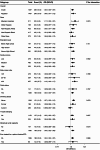Association of relative fat mass with female infertility: a cross-sectional study based on NHANES 2017-2020
- PMID: 40595186
- PMCID: PMC12215735
- DOI: 10.1038/s41598-025-08595-x
Association of relative fat mass with female infertility: a cross-sectional study based on NHANES 2017-2020
Abstract
Relative Fat Mass (RFM) is an emerging body fat measurement index that more accurately reflects the distribution of visceral fat. This study aimed to investigate the association between RFM and female infertility. We utilized data from the National Health and Nutrition Examination Survey (NHANES) spanning from 2017 to 2020, enrolling 1487 female participants aged 20-44. The relationship between RFM and infertility was analyzed using multivariate Logistic regression, and the dose-response relationship was assessed with Restricted Cubic Splines (RCS). The study found a significant association between RFM and infertility. After adjusting for confounders such as age, ethnicity, and BMI, each unit increase in RFM was associated with a 6% increase in the risk of infertility (OR = 1.06, 95%CI = 1.01-1.12, P = 0.019), with stable results across different subgroups. RFM is significantly associated with female infertility and may serve as a useful tool in infertility screening. Future studies should further validate its potential for clinical application.
Keywords: Body fat; Infertility; NHANES; Relative fat mass; Reproductive health.
© 2025. The Author(s).
Conflict of interest statement
Declarations. Ethics approval and consent to participate: Not applicable. Consent for publication: Not applicable. Competing interests: The authors declare no competing interests.
Figures



Similar articles
-
The association between obesity-related indicators and female infertility: the United States National Health and Nutrition Examination Survey, 2013-2018.Front Endocrinol (Lausanne). 2025 Jun 23;16:1588965. doi: 10.3389/fendo.2025.1588965. eCollection 2025. Front Endocrinol (Lausanne). 2025. PMID: 40626237 Free PMC article.
-
Relative fat mass as a predictor of gallstones: insights from national health and nutrition examination survey data.Lipids Health Dis. 2025 Mar 1;24(1):78. doi: 10.1186/s12944-025-02480-2. Lipids Health Dis. 2025. PMID: 40025500 Free PMC article.
-
Relative Fat Mass and Psoriasis Risk: Evidence from NHANES 2009-2014.J Multidiscip Healthc. 2025 Jul 29;18:4365-4376. doi: 10.2147/JMDH.S532383. eCollection 2025. J Multidiscip Healthc. 2025. PMID: 40761585 Free PMC article.
-
Antioxidants for male subfertility.Cochrane Database Syst Rev. 2022 May 4;5(5):CD007411. doi: 10.1002/14651858.CD007411.pub5. Cochrane Database Syst Rev. 2022. PMID: 35506389 Free PMC article.
-
Nutritional supplementation for stable chronic obstructive pulmonary disease.Cochrane Database Syst Rev. 2012 Dec 12;12(12):CD000998. doi: 10.1002/14651858.CD000998.pub3. Cochrane Database Syst Rev. 2012. PMID: 23235577 Free PMC article.
References
-
- Boivin, J. et al. International estimates of infertility prevalence and treatment-seeking: potential need and demand for infertility medical care. Hum. Reprod.22 (6), 1506–1512 (2007). - PubMed
-
- Evers, J. L. Female subfertility. Lancet360 (9327), 151–159 (2002). - PubMed
-
- Infertility Workup for the Women’s Health Specialist. ACOG committee opinion, number 781. Obstet. Gynecol.133 (6), e377–e384 (2019). - PubMed
MeSH terms
Grants and funding
LinkOut - more resources
Full Text Sources
Medical

